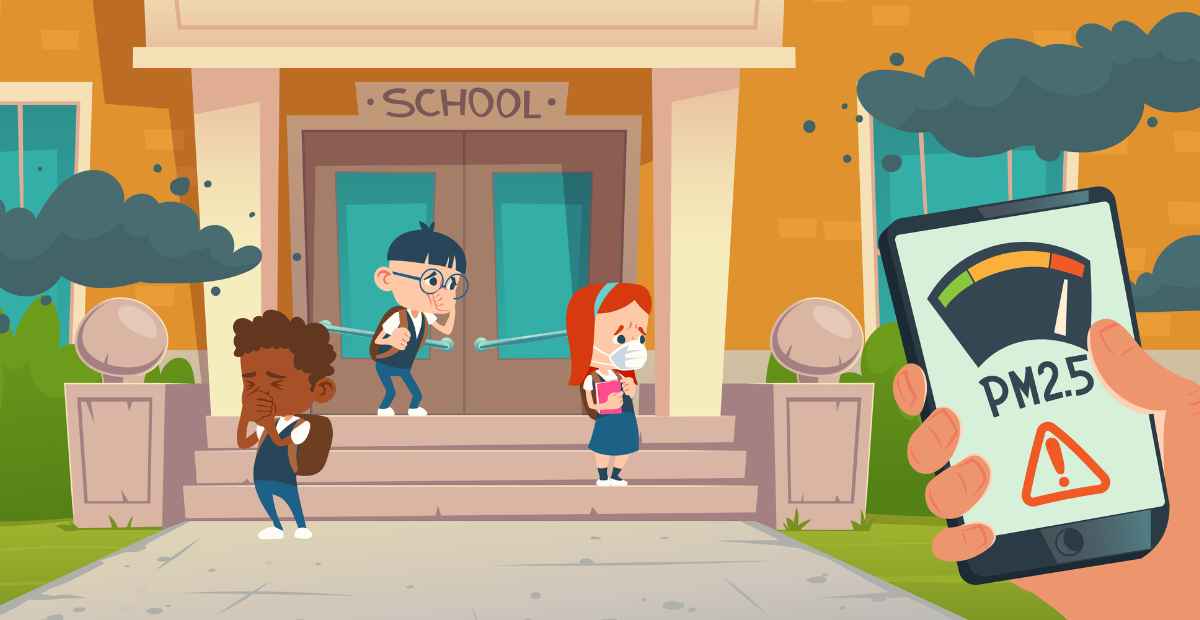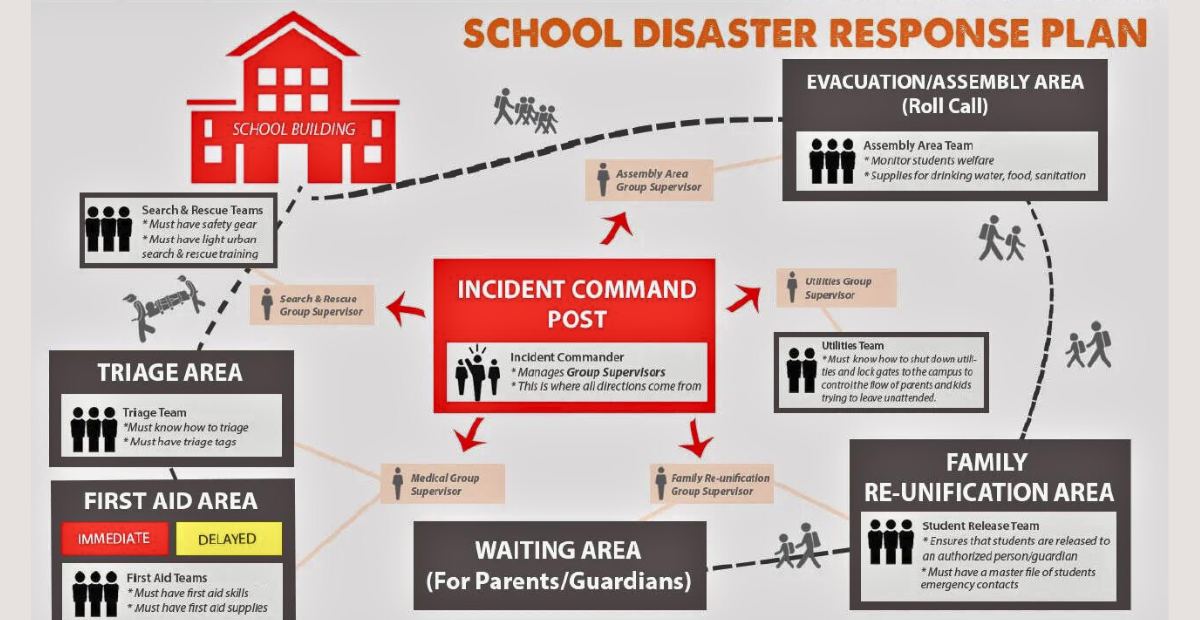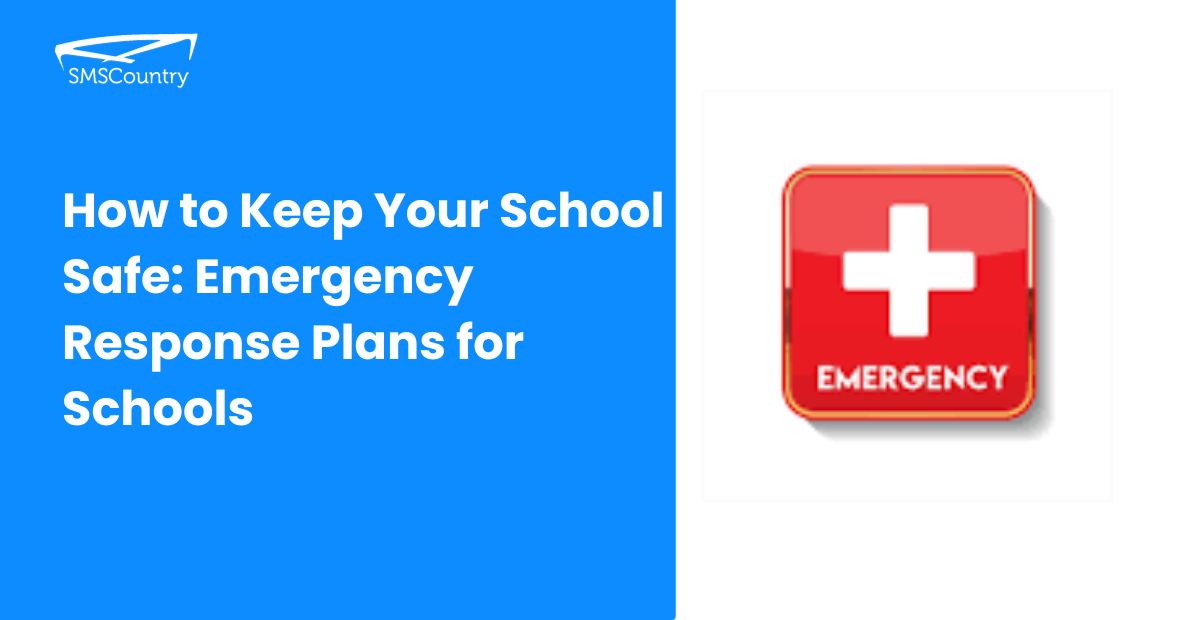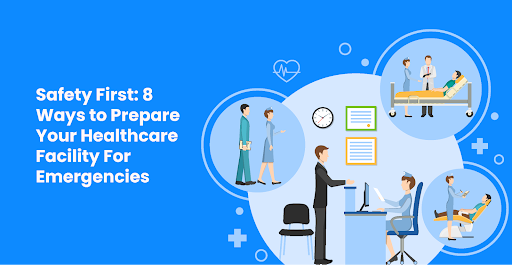Have you ever felt worried about your school’s safety during an emergency?
Maybe you’ve thought about what would happen if there was a fire, earthquake, or even an intruder.
It can get scary to think about, so you must always have a plan and be ready. That’s where an emergency response plan for your school comes in.
This article shares tips and tricks for keeping your school safe during an emergency.
You’ll feel more confident and prepared to handle any situation.
So let’s get started.
What is an emergency?
An emergency is an event that needs quick action or attention to prevent harm or danger.
Sadly, schools are not left out. One common emergency is fire, which can break out for many reasons.
Another example is an earthquake, which can cause the building to shake or collapse. We’ve also seen shootings in schools, which can cause harm to students and staff.
All these are serious emergencies that need quick action to keep everyone safe.
Learn how to use SMS to transform education administrative processes in your school
What kind of emergencies should you prepare for?

Many types of emergencies can happen in your school. These emergencies can affect students, staff, and the entire community differently.
Here are some examples:
- Natural disasters: These are things like earthquakes, floods, and hurricanes. These types of emergencies can damage buildings and cause injuries or even fatalities. This is why you need a disaster management plan for your school.
- Fires: Fires can start for many different reasons. It can be electrical problems or cooking accidents. They can cause damage to the school building and put everyone inside at risk of injury or harm.
- Violence: Violence can also occur in schools. This can include fights between students, bullying, and even shootings. These emergencies can affect students, staff, and the entire community.
- Medical emergencies: Students or staff members may have a medical emergency. For example, a seizure or a heart attack. In these situations, quick action is necessary to provide necessary medical care.
During emergencies, there will be fear, confusion, and anxiety. That’s why you need an emergency response plan for your school.
Why should you prepare your school for emergencies?
It’s much better when everyone in your school knows what to do during an emergency. There’s less confusion and panic, and everyone is likelier to make it out safely.
For example, imagine a school where the students and staff practised safety drills. Everyone knows where the exits are and how to communicate during an emergency.
Everyone gets to evacuate the building quickly and safely if a fire occurs.
Or, if there is an intruder, everyone would know to hide and stay quiet until help arrives.
Having an emergency response plan for your school makes everyone stay calm. Then, you get to make the best decisions during an emergency.
There are many real-life examples of schools’ responses to emergencies.
For example, in 2018, there was a school shooting in Maryland, USA. Before the event, they had practised school lockdown procedures and had a safety plan.
As soon as the shooting started, staff members locked doors and helped students to safety.
Everyone made it out safely thanks to their school emergency plan and quick thinking. Having an emergency plan can save lives during a crisis.
You don’t want to miss this next part.
See the ultimate back-to-school checklist for school owners.
How to prepare an emergency response plan for your school
Are you ready to start drawing out your emergency plan?
Here are things you must do to prepare your school emergency response plan adequately.
Identify potential emergencies
You need to identify potential emergencies that could happen in your school. This is the first step in creating an emergency response plan.
Here are tips on how to do it:
- Look at your school’s location: Your location can affect the type of emergency. For example, if your school is in an area prone to earthquakes, you should plan for earthquakes.
- Consider age: Younger and older students will have different needs during emergencies. For example, younger students may need more help during an evacuation.
- Review past emergencies: Look at past crises in your school. This gives you an idea of what types of emergencies can likely happen.
- Draft a school safety audit: Identify potential hazards and assess their likelihood and severity. You can use a risk assessment to rank your planning efforts.
- Involve stakeholders: Involve key stakeholders in finding potential emergencies. For example, teachers, staff members, and parents. They may have valuable ideas that you didn’t think of for your school emergency response plan.
By taking these steps, you can identify potential emergencies in your school. You can also create an emergency response plan catering to your needs.
Learn how to manage your entire school from a spreadsheet.
Develop an emergency plan
Creating a school emergency response plan is essential to keeping your school safe.
Here is a guide to creating a school emergency plan:
- Step 1: Assemble a team. Create a group of key stakeholders. They should work together to create the plan and ensure everyone is on the same page.
- Step 2: Identify potential emergencies. Using the tips we discussed, find potential emergencies that are most likely to occur.
- Step 3: Determine emergency procedures. For each potential emergency, determine the specific strategies you should follow. For example, create different approaches for a fire, an earthquake, or a flooding incident.
- Step 4: Assign responsibilities. Choose who will be responsible for the emergency plan. Assign roles to staff members. Pick who will call emergency services or lead students to safety.
- Step 5: Communicate the plan. Ensure staff members and students know about the emergency plan. They must also understand their roles. You may have to hold regular emergency drills.
It’s not enough to follow these steps. You also need to do the following when drafting your school emergency response plan:
- Have clear procedures for each potential emergency.
- Assign roles and responsibilities for staff members.
- Create a communication plan for alerting emergency responders and parents.
- Draw out evacuation routes and assembly points.
- Add procedures for students with special needs.
- Have a plan to unite with parents or guardians after an emergency.

Source:shopify.com
Keep emergency kits around the premises
Having emergency kits is a vital part of your school emergency response plan.
Emergency kits are like survival packs. They can help you keep your school safe in an emergency.
Here are some items you should have in your emergency kit:
- First aid supplies: These are bandages, gauze, disinfectant, and other medical supplies to treat injuries.
- Water: You need access to clean drinking water in an emergency. Be sure to include enough water for all students and staff.
- Non-perishable food: Granola bars and canned goods can keep everyone fed in an emergency.
- Flashlights and batteries: You can use these to navigate in the dark or signal for help.
- Blankets: In an emergency where students and staff must stay put. You can use blankets to keep everyone warm and comfortable.
- Whistles: You can use whistles to signal for help or gather people together.
- Maps: Maps of the school and surrounding area can greatly help. Emergency responders can easily navigate and find those who need help.
Try to keep several emergency kits in different locations around the school. For example, classrooms, hallways, and the main offices. Also, ensure everyone knows where the kits are and how to use them.
| See the top bulk SMS service providers to send transactional and promotional SMS. Check out the top OTP service providers to send fast and secure OTPs. |
Train and educate faculty and staff
Having a school emergency response plan and kits is not enough. You must train your staff to carry out the plan and use the kits in an emergency.
You can conduct these training programs as online courses, in-person workshops, and drills.
The type you choose will depend on your school’s needs and resources.
Here are reasons why you need to train your staff for emergencies:
- To learn the know-how: Training helps everyone know their roles during an emergency.
- To ensure a quick response: Staff can respond quickly with proper training. This will increase the possibility of saving lives.
- To reduce panic: Knowing what to do in an emergency reduces panic among students and staff.
How do you carry out this training for your students and staff?
Here are some tips to help you provide education and training to ensure readiness:
- Have regular drills: Practice makes perfect. Regular drills help keep everyone prepared and ready to respond in an emergency.
- Offer online courses: Online courses can be a convenient and cost-effective way to provide training to staff.
- Offer refresher courses: Even if you’ve had training programs in the past, that’s not all. Provide refresher courses to ensure that everyone is up-to-date and ready.
Involve students and parents
Don’t forget you have to carry students and parents along in your school emergency response plan. Here’s why:
- Students and parents can help identify things that could be dangerous. Working together lets you plan what to do if something bad happens.
- You can train students and parents on what to do during an emergency. That way, everyone knows how to stay safe and help others.
- It’s helpful to have everyone unite and support each other during an emergency. Students and parents can help make sure everyone stays calm and feels okay.
How do you involve parents and students in your? Here are some ways to go about it:
- Ask students and parents for their ideas for your school emergency response plan.
- Practice what to do during an emergency. You might have drills at school where you practice staying safe.
- Talk to your students or parents about any concerns you have. Make sure everyone feels prepared and ready for anything that might happen.
That’s not all. We have some quick examples of students and parents involved in school emergency planning:
- Safety committees where students help develop plans to keep everyone safe during emergencies.
- Parents volunteer to help out during emergency drills and put together the kits.
- Students lead evacuation drills to ensure everyone gets out safely.
By working together as a team, everyone gets prepared for unexpected situations.
It gets interesting. Let’s take a look at the next emergency response plan.
Conduct emergency drills and exercises
Drills and exercises are fundamental in your preparation. It’s a way to rehearse what you’ll do in an emergency. It also helps everyone to stay fit.
Here are some types of drills:
- Fire drills: These drills help people know how to get out of the building quickly and safely in case of a fire.
- Lockdown drills: These drills help people know what to do in a dangerous situation, like an intruder, and how to stay safe.
- Shelter-in-place drills: These drills help you learn how to stay safe in a hazardous situation. For example, a severe storm.
To conduct drills effectively, follow these steps:
- Let everyone know beforehand: Tell everyone that there will be a drill so they can prepare.
- Give clear instructions: During the drill, give clear and simple instructions. This way, everyone knows what to do.
- Evaluate the drill – After the drill, think about what went well and what could be better next time.
- Update the emergency plan: Use what you learned from the drill to improve the emergency plan.
You need to evaluate and update emergency plans based on your drill results. This will help ensure your plan is strong enough to handle any emergency.
Build community partnerships
Community partnerships are important to prepare your school for emergencies.
Also, learn how to protect your school’s digital accounts with 2FA.
Here are some examples of community partnerships that can help your school get ready:
- Local emergency responders: Emergency units can teach you how to handle emergencies. For example, the police, firefighters and medical services.
- Businesses: Local businesses and organisations can give you supplies, volunteers, and experts.
- Parent-teacher organisations: These groups can teach parents and students about emergency plans. They can also provide monetary and human support.
Don’t forget that you need to build healthy relationships with your community partners. Here are ways you can do that:
- Think of people and businesses in the community that can help with your school’s emergency preparedness.
- Get to know potential partners and build a relationship based on trust.
- Keep partners informed about your school emergency plans and ask for their support.
- Say thank you to community partners and recognise the help they provide.
But that is still not all you have to do. Communication is an important part of any school emergency response plan.
Let’s see how you can communicate during a school emergency.
Using SMS for emergency communication
When there’s an emergency at school, you must talk to students, parents, and staff as fast as possible. One way to speak to them is through text messaging.
Here are ways that you can use SMS to communicate during an emergency:
- Send alerts: Let’s say there’s an emergency happening, like an active shooter on campus. You can text everyone’s phones to tell them what’s happening and what they should do to stay safe.
- Share updates: After an emergency starts, you must keep everyone informed about what’s happening. You can send SMS messages to give updates on the situation, like when it’s safe to leave or when the emergency is over.
- Check-in: During an emergency, ensuring everyone is okay is important. Schools can use SMS to check in with students and staff to ensure they’re safe and see if anyone needs help.
- Ask for help: You can set up SMS short code services that students or staff can use to ask for help during or after an emergency.
Using SMS is a good way for schools to talk to many people at once during an emergency.
But ensure that everyone’s phone number is correct and up-to-date. Also, ensure everyone knows what to do when they get an SMS message during an emergency.
Don’t forget to create a plan for using SMS during an emergency. Practice that plan often so it can work well.
| SMSCountry is the best bulk SMS service to delight your students. Learn more about our SMS services. Get started or schedule a demo. |
What are the benefits of using SMS for emergency communication?
Here are some benefits of using SMS for emergency communication:
- Quick and reliable: SMS is fast and reliable. Your messages are usually delivered within seconds. This makes it an effective way to reach many people during an emergency quickly.
- Reach everyone: You can send SMS messages to the school community. The best part is that they don’t need a smartphone or internet access.
- Cost-effective: Sending SMS messages is usually much cheaper than making phone calls. Also, SMS messages can be more efficient than sending out physical notices or emails.
- Trackable: You can track your SMS messages to ensure they reach your recipients. Some systems even allow two-way communication so that recipients can respond to messages.
- Personalised: You can personalise your SMS messages. With this, you can target specific groups of people with unique info.
Safeguard your school with SMSCountry bulk SMS
Ensuring your school is safe during emergencies is important. That’s why a good emergency response plan is key.
Looking for the best SMS service provider to help deliver quick and reliable SMS during emergencies?
Look no further. SMSCountry is here to lighten your burdens.
SMSCountry is a bulk SMS service that’s easy to use and offers 24/7 support. So you can send messages to students, parents, and staff anytime.
Schedule a free demo to learn how SMSCountry helps you stay safe during an emergency.
Or sign up for free to communicate quickly and get help during danger.
FAQs about emergency response plan for schools
What is a school emergency operation plan?
A school emergency operation plan is a plan to keep everyone safe during an emergency. It includes evacuation routes and ways to communicate. Everyone needs to know about the plan and practice it.
What are the five steps of emergency management?
Prevention – taking steps to prevent an emergency from happening
Mitigation – lessening the impact of an emergency if it does happen
Preparedness – planning and preparing for emergencies before they occur
Response – taking immediate action to address the emergency and keep people safe
Recovery – returning to normal operations and rebuilding after the emergency has passed.
What are the benefits of emergency response?
Emergency responses prevent fatalities and injuries and reduce damage to buildings, stock, and equipment.
How do you respond to emergencies in schools?
If there’s an emergency at school, you must stay calm and listen to the instructions. School staff, the police, and others keep you safe. Keep your phone close and follow their directions to stay safe.



